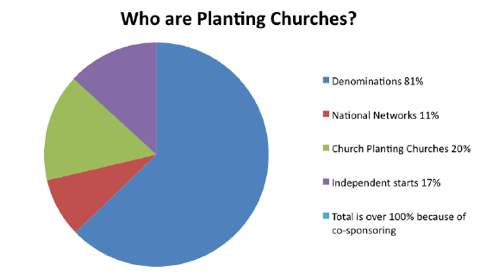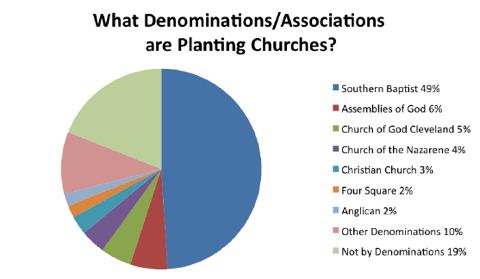
You Can’t Love a City if You Don’t Know a City, Part 4
I’ve been working through some idea about researching a city in order to reach a city.
In part 2, I introduced a case study of church planting in Baltimore / Washington. This study is an unpublished report on the current state of church planting in the Washington DC and Baltimore Corridor focuses on identifying the church plants and who is planting them.
I found it fascinating and one helpful element to understanding what God is doing in a city.
Here is more from that study.
—————————————————————————————
Church Planting in Washington DC / Baltimore Corridor
New Church Plants Identified
Church planting has continued to expand over the last five years.
- 274 churches were identified that have started in the last 5 years
- It is estimated that as many as 70 churches or a quarter of the total of the new churches have not been identified. These churches are usually independent, non-English speaking, small denominations, or house churches, etc…
The Following Questions Relate to the 274 Identified Churches.
Who are Planting Churches?
Denominations/associations lead the way over all other efforts combined in the planting of churches.
222 churches were planted by denominations/associations 81%
31 by national and local networks 11%
54 by church planting churches (have planted 3 or more churches) 20%
47 are independent plants 17%
The total adds up to over 274 and over 100% because of co-sponsoring between church planting churches, networks, and denominations.
What Denominations/Associations are Planting Churches?
22 denominations/associations were identified for planting churches. Southern Baptists are starting 49% of the new churches.
133 by Southern Baptist 49%
17 by Assemblies of God 6%
14 by Church of God Cleveland 5%
10 by Church of the Nazarene 4%
9 by Christian Church 3%
6 by Foursquare 2%
6 by Anglican 2%
27 by other denominations/associations 10%
52 not by denominations 19%
What Networks are Planting Churches?
National networks are just getting established in the area. Although few in number, the pastors generally have more training, are better funded, and experience a higher survivability rate.
8 by Baltimore/Washington Christian Church network **
5 by Ecclesia *
3 by Stadia
3 by Orchard
2 by Acts 29
2 by ARC *
2 by Liberty
2 by New Thing
2 by Redeemer City to City *
2 by SENT **
1 by Kairos
1 by Virginia Evangelizing Fellowship
0 by Calvary
0 by Launch
by Mosaic *
by Vision 360
* National Network with a local representative
**Local Network
Who are the Church Planting Churches (churches planting 3 or more churches in our metro areas in the last 5 years)?
Although other churches were church planting churches 10, 15, or 20 years ago, most of these became church planting churches in the last 5 years. These church planting churches have been identified.
5 Capital Baptist Church, Annandale, VA
5 Mountain Christian, Jappa, MD** ***
5 New Life Christian, Chantilly, VA** ***
4 National Community Church, DC*
4 New Life Wesleyan Church, Waldorf, MD
4 Northwest Baptist Church, Reisterstown, MD
3 Capitol Hill Baptist Church, DC***
3 Church of the Resurrection, DC***
3 Grace Fellowship Church, Timonium, MD**
3 McLean Bible Church, VA*
3 Frontline of McLean Bible Church, VA*
3 by The Gathering of McLean Bible Church, VA*
3 Pathways Church, Bel Air, MD
3 The Falls Church, Falls Church, VA***
3 Word of Life Int. Church, Ashburn, MD
*Churches who are planting exclusively through multi-site locations.
**Churches planting through multi-site locations and new churches
***Churches with internship/residency programs for new church planting pastors
“For God did Not Give Us a Spirit of Timidity, But a Spirit of Power, of Love and of Self-Discipline.” 2 Timothy 1:7
—————————————————————————————
I find the list interesting. The people involved in the research tend to be non-denominational (with a Restoration / Independent Christian streak) so they are not generally denominational apologists. Thus, the overwhelming number of church plants being denominational is worth noting. When you combine Southern Baptists (who planted almost half) and Pentecostals (Assemblies of God, Church of God Cleveland, and Foursquare), you see a strong majority of the churches. Also of note: the lack of plants from mainline denominations.
Now, they may have missed some plants (though they worked hard to identify them), but I found this interesting. Networks get a lot of press and are doing great things, but denominations are doing much of the planting in this area. (It is probably helpful to note that the SBC targeted this region through something called Strategic Focus Cities, a denominational church planting initiative, and that probably increased the SBC numbers more than you would see in another city).
Read more on this series: Part 1; Part 2; Part 3; Part 5.
Read more from Ed here.
















